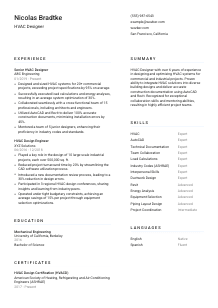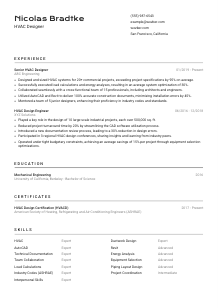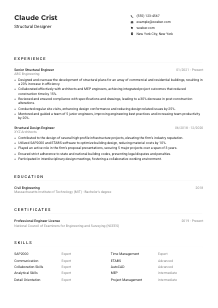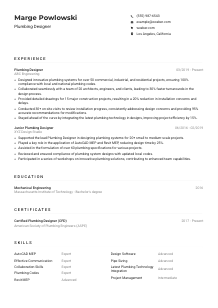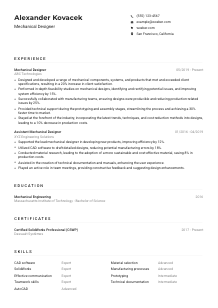HVAC Designer Resume Example
Designing climate control systems, but your resume feels drafty? Explore this HVAC Designer resume example, engineered with Wozber free resume builder. Discover how you can sync your ventilation and air parameters with job specifics, ensuring your career trajectory is always set on high efficiency and optimal comfort!

How to write a HVAC Designer Resume?
Embarking on the path of an HVAC Designer? Fantastic choice! Your resume, a vessel of your achievements, needs to resonate not just with experience, but with purpose and precision. Tailoring your resume for an HVAC Designer position isn't about filling a template; it's about bridging your abilities with the job's heart.
With Wozber's free resume builder, we'll navigate the nuances of engineering your career story to mirror the meticulous demands of the HVAC Design domain. Harnessing ATS-friendly resume templates and diving deep with ATS optimization, let's turn your resume into a beacon for hiring managers!
Personal Details
In the realm of resumes, first impressions are crucial, especially when your goal is to align with the HVAC Designer position. Your Personal Details section is your first handshake with potential employers. Here's how to ensure it's a firm, confident one:
1. Your Name
Like a brand emblem, your name should be memorable. Position it prominently, using a clear, professional font. Stand out, but maintain a professional demeanor.
2. Titling Yourself Right
Following your name, note down the job title you're aspiring for - "HVAC Designer". This tailoring trick aligns your resume's direction right from the start and mirrors the job you are laser-focused on.
3. Essential Contact Info
- Phone Number: Your lifeline to potential interviews. Ensure it's your best contact number with zero errors.
- Professional Email Address: Go for simplicity and professionalism. Stick to a variant of firstname.lastname@example.com to keep it straightforward.
4. Location Matters
For an HVAC Designer looking to work in San Francisco, stating "San Francisco, California" lets the employer know you're local or prepared to relocate, ticking another box in the compatibility checklist.
5. Digital Presence
Including a LinkedIn profile or a personal webpage can add depth to your resume. Ensure they're polished and echo the professional narrative of your resume.
Takeaway
Keep the personal details section concise yet informative, establishing a professional yet approachable first impression. It's the portal into your resume, make every detail count.





Experience
Experience is the powerhouse of your resume. It's where you demonstrate how your journey aligns perfectly with the HVAC Designer role. Let's explore how to make your experience gleam with relevance:
- Designed and sized HVAC systems for 20+ commercial projects, exceeding project specifications by 95% on average.
- Successfully executed load calculations and energy analyses, resulting in an average system optimization of 30%.
- Collaborated seamlessly with a cross‑functional team of 15 professionals, including architects and engineers.
- Utilized AutoCAD and Revit to deliver 100% accurate construction documents, minimizing installation errors by 45%.
- Mentored a team of 5 junior designers, enhancing their proficiency in industry codes and standards.
- Played a key role in the design of 10 large‑scale industrial projects, each over 500,000 sq. ft.
- Reduced project turnaround time by 20% by streamlining the CAD software utilization process.
- Introduced a new documentation review process, leading to a 30% reduction in design errors.
- Participated in 3 regional HVAC design conferences, sharing insights and learning from industry peers.
- Operated under tight budgetary constraints, achieving an average savings of 15% per project through equipment selection optimizations.
1. Dissect the Job Spec
Start by highlighting phrases from the job description - "designed HVAC systems", "cross-functional team collaboration", "AutoCAD and Revit proficiency". These will act as your keywords and guiding stars.
2. Strategize Your History
Structuring your experience with a reverse-chronological order puts your most recent (and likely most relevant) roles in the spotlight. Be clear with your titles, employment dates, and company names.
3. Tailored Achievements
Here's where you transform duties into stories of success. Link your achievements directly with the job specs — used AutoCAD for precision in design, or led a cross-functional team to exceed project specifications.
4. Quantify Success
Quantifiable achievements can significantly amplify your impact. If you optimized systems by 30% or were integral in cutting costs by 15%, state these figures. They paint a picture of capability and result.
5. Relevance is King
Keep every point sharply focused on what matters to an HVAC Designer role. Each bullet point is a chapter of your story; make it compelling and utterly relevant to the narrative you're aiming to partake in.
Takeaway
Your experience section is not just a recount of your job history; it's a persuasive argument on why you're an ideal fit for the HVAC Designer role. Be meticulous, purposeful, and let each achievement underscore your potential.
Education
The roots of your expertise lie within the realm of your education. Here's how to ensure your educational background aligns flawlessly with the HVAC Designer role:
1. Match Key Requirements
The job description asks for a "Bachelor's degree in Mechanical Engineering". If your education aligns, make it the star of this section. This direct match is a powerful first qualifier for your resume.
2. Clarity and Conciseness
Adhere to a clear structure - degree, field, institution, and completion year. This straightforward formatting aids in ATS optimization and makes the section easy for hiring managers to scan.
3. Showcase Exact Matches
For the HVAC Designer role, listing a Bachelor of Science in Mechanical Engineering is perfect. It instantly tells the hiring manager you have the fundamental credentials required.
4. Relevant Coursework and Projects
If early in your career, underlining specific courses or projects related to HVAC design can give you an edge. It's about showing you've not just learned but engaged deeply with your field.
5. Additional Honors and Activities
Graduating summa cum laude or leading a relevant academic club can also be valuable, especially if you're at the genesis of your career. Highlight any element that adds weight to your HVAC Designer credentials.
Takeaway
The aim is to present an education section that speaks directly to the HVAC Designer role, affirming your academic foundation and enthusiasm for the field. Align closely with job requirements and watch your resume rise to the top.
Certificates
In a competitive field like HVAC design, certifications can significantly buttress your expertise. Crafting the certification section with intent can be your secret weapon:
1. Home in on the Job Needs
While the given job description doesn't specify necessary certifications, having an "HVAC Design Certification (HVACD)" showcases a dedicated commitment to your craft.
2. Relevance Over Quantity
Focus on certifications that directly reinforce your qualification for the HVAC Designer role. This ensures the hiring manager sees value in your continued education and expertise.
3. Transparent Timing
Being upfront about the acquisition or validity of your certifications demonstrates your current engagement with your profession's standards and advancements.
4. Always Be Evolving
The HVAC field, like all technology-dependent fields, evolves. Keeping your certifications up to date is not just about adding badges to your resume but staying at the forefront of your profession.
Takeaway
Leverage your certifications as clear evidence of your ongoing dedication and proficiency in the HVAC design arena. Carefully select and present certifications that align with your career aspirations and the role in question.
Skills
The realm of HVAC design demands a mix of specific technical and soft skills. Here's how to curate a skills section that resonates with the precision of an HVAC Designer:
1. Decode the Job Spec
The job description serves as a treasure map for identifying crucial skills. Phrases like "proficiency in AutoCAD" or "knowledge of ASHRAE standards" guide you to list those specific skills.
2. Customized Skillset
Prioritize skills mentioned in the job listing, aligning your abilities with the requirements. Whether it's your expertise in Revit or your seamless team collaboration, make the connection clear.
3. Sharp and Focused
Resist the urge to overload this section. A curated list of directly relevant skills speaks louder than a lengthy generic one. Utilize Wozber's ATS optimization features to refine your selection.
Takeaway
Your skills section is a concise showcase of why you're a perfect fit for the HVAC Designer role. Tailor it with precision, keep it relevant, and let your professional toolkit shine.
Languages
In the diverse field of HVAC Design, being multilingual can be an asset, especially in communication and understanding project needs. While not always a requirement, showcasing your language proficiency could set you apart:
1. Job Spec Scan
"Strong proficiency in English needed" - this line from our job description is a direct call to highlight your proficiency in English as a top priority.
2. Prioritize the Must-Haves
Start with English, listing it along with your proficiency level. This aligns with the job's demands and immediately ticks a crucial box for the hiring manager.
3. List Additional Languages
Secondary languages can be a bonus. While the job might not explicitly require them, additional languages illustrate your ability to navigate diverse work environments.
4. Be Honest
Accuracy in representing your language proficiency is key. Overstating your fluency could lead to uncomfortable situations, so stick with truthful self-assessment.
5. Tailored to the Role
While our HVAC Designer role may not necessitate multiple languages, understanding the role's scope can help you decide which languages to feature, if any beyond the essentials.
Takeaway
Your ability to communicate in various languages is more than an ability; it's a testament to your flexibility and readiness in our ever-globalizing world. Highlight it with honesty and consider its relevance to the HVAC Designer role.
Summary
Your resume summary is your chance to grab attention and articulate why you're the perfect HVAC Designer in a few impactful lines. It's your career narrative's opening act:
1. Job Essence Comprehension
Start by internalizing the job description. Identify keywords and core requirements that the employer values highly for the HVAC Designer position.
2. Professional Introduction
Open your summary with a concise statement about your professional identity and experience. Position yourself as a confident HVAC Designer ready to take on project challenges.
3. Key Skills and Achievements
Highlight your prime skills and achievements next. Use the job description as a guide to align your achievements with the employer's priorities, like proficiency in CAD software and system optimization.
4. Brevity is Key
Keep your summary tight and potent. Aim for 3-5 compelling lines that capture the essence of your professional value and how it aligns with the role's requirements.
Takeaway
Your summary is the golden opportunity to make a memorable first impression. Craft it with intention to project your suitability and readiness for the HVAC Designer role. Remember, it sets the tone for the narrative that unfolds in your resume.
Launching Your HVAC Designer Journey
With every section of your resume thoughtfully tailored using insights from Wozber's ATS-friendly resume format, you've crafted not just a document, but a narrative that resonates with your desired role. The journey towards becoming an HVAC Designer is paved with dedication, skill, and the right resume to open doors. Forge ahead with confidence; your meticulously tailored resume is your ambassador in the professional world.
Ready to take that next step? Dive into Wozber's free resume builder and let your story shine!

- Bachelor's degree in Mechanical Engineering or an equivalent field.
- Minimum of 5 years experience in HVAC system design, preferably in commercial or industrial projects.
- Proficiency in CAD software, such as AutoCAD or Revit, for designing and documenting HVAC systems.
- Strong knowledge of industry codes and standards, including ASHRAE and local building codes.
- Excellent communication and interpersonal skills to collaborate with clients, architects, and project teams.
- Strong proficiency in English needed.
- Must be located in or willing to relocate to San Francisco, CA.
- Design and size HVAC systems, including equipment selection, ductwork, and piping layouts, to meet project specifications and local building codes.
- Coordinate with architects, structural, and electrical teams to ensure integration of HVAC systems into building designs.
- Perform load calculations, energy analysis, and make necessary adjustments for system optimization and efficiency.
- Prepare construction documents, specifications, and maintain project documentation throughout the design and construction processes.
- Provide technical support and guidance to installation, maintenance, and troubleshooting teams on HVAC systems.





